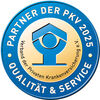Quality data and quality assurance
Various indicators provide information about quality at Uniklinik RWHTH Aachen and help us to safeguard it in the long term. Here you will find further data on quality at our hospital.
Since 2005, hospitals have been legally obliged to provide information about their work in quality reports. Quality reports provide an overview of hospital structures and services. For example, they contain information on the range of diagnoses and treatments, the frequency of treatment, staffing levels and the number of complications, as well as accessibility.
Here you can get an insight into the quality reports of Uniklinik RWTH Aachen:
- Structured Quality Report 2022
- Structured quality report 2021
- Structured Quality Report 2020
- Structured quality report 2019
- Structured quality report 2018
- Structured Quality Report 2017
- Structured quality report 2016
- Structured Quality Report 2015
The Verband der Universitätsklinika Deutschlands (VUD) represents the 33 university hospitals in Germany. The brochure “Quality of Life” provides a university comparison of facts and figures on basic therapies and treatment procedures at university hospitals in Germany. The special services of university medicine and their significance in the healthcare landscape are presented. The current version of the brochure (facts and figures) can be found here:

Uniklinik RWTH Aachen and the Verband der Privaten Krankenversicherung (PKV) have been in a quality partnership since 2016. This is based on both high-quality offers for private and optional service patients in terms of accommodation and service, as well as above-average results in the mandatory external quality assurance (EQS).
The legal basis for external quality assurance, which is increasingly being operated across facilities and sectors, are the provisions of § 137, § 135 and § 112 of the German Social Code V. The provisions apply to all acute hospitals and their implementation is regularly updated by the Joint Federal Committee.
The aim of the EQS is to make certain hospital services comparable with the help of suitable quality indicators. The target value is always the benefit for the patient. For this purpose, certain service areas are defined by the Federal Joint Committee, for which all German hospitals collect defined, quality-relevant data. The data is evaluated by central, independent institutions. Conspicuous results are an immediate reason to introduce targeted improvements. Another advantage of EQS is that this data enables comparability between hospitals. However, the fact that patients at university hospitals are often sicker and more complex than elsewhere is not yet sufficiently taken into account.
In the Quality Medicine Initiative (IQM), hospitals from Germany and Switzerland are voluntarily committed to improving medical quality in the treatment of their patients. Its aim is to make existing potential for improvement in medicine visible and to raise it for the benefit of patients through active error management. To this end, IQM provides medical experts from participating hospitals with innovative and user-friendly tools.
In the Quality Medicine Initiative, around 500 hospitals are currently committed to improving quality in medicine across all countries and organizations. In Germany and Switzerland, IQM members treat around 7.8 million inpatients every year. This corresponds to a share of 40 percent in Germany and around 35 percent in Switzerland.
Measuring quality with routine data
The German flat rate per case system makes it possible to derive extensive quality information from hospital billing data: Every service in the hospital is coded in the course of billing and mapped in so-called ICD (International Classifi cation of Diseases) or OPS (Operation and Procedure Codes). This routine data is checked by the payers, records every patient treated and is available at short notice. Measuring quality using quality indicators based on routine data therefore means high efficiency (no additional documentation effort in the clinics) and objectivity (easy to check).
Publication of the results
All IQM members undertake to publish their results from inpatient treatments. RWTH Aachen University Hospital has been doing this since 2008. For a better understanding of the logic and objectives, we recommend the reading guide to the IQM quality indicators (PDF).
- Quality results IQM Uniklinik RWTH Aachen
- Quality results Uniklinik RWTH Aachen - Franziskus
- QSR Clinic Report
Peer review process
In peer reviews, treatment processes are specifically assessed by external head physicians and examined for improvement potential. The “peers”, i.e. experienced medical colleagues, examine and advise us in a structured and unbiased manner. Important insights are gained from these reviews, which further improve our results and make patient care even safer.
You can find out more about the Quality Medicine Initiative on the IQM homepage.







